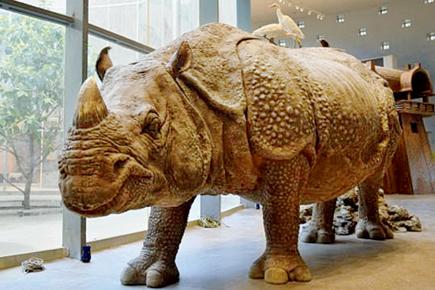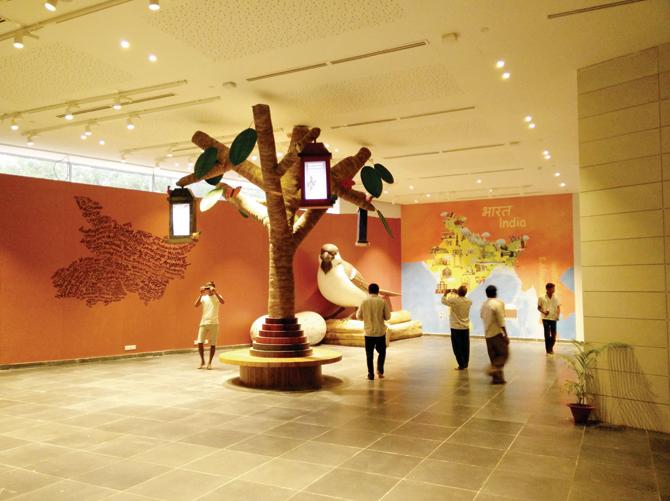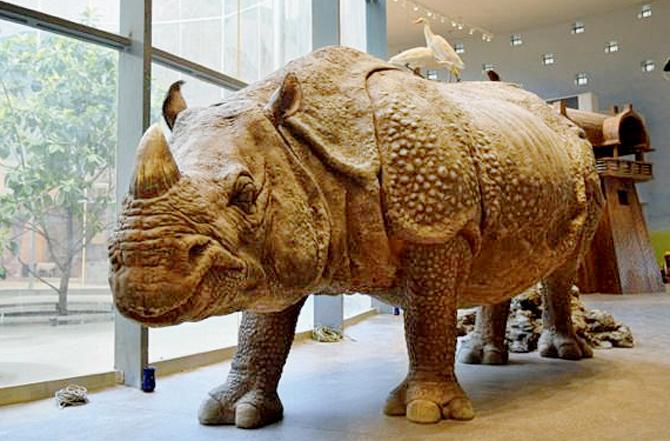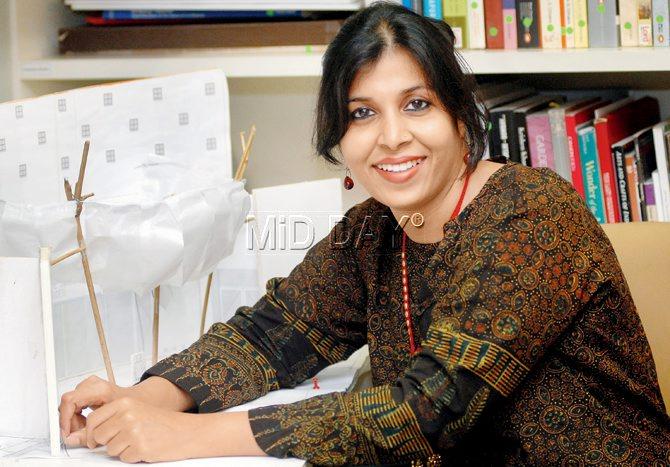The Mumbai cultural planner and brain behind Patna’s state-of-the-art museum, on what it means to think Bihar-size big

A star attraction is the imposing GFRC (Glass Fibre Reinforced Concrete) rhino made in Xiamen, China. Behind him lies a mound of fake poop.
 Batul Raaj Mehta sits in her Parel office, 1800 kms away from Patna, recreating for us the experience of walking into the just-launched Bihar Museum, touted as ground-breaking. At the entrance to the Children’s Gallery, which opened to visitors on August 7, a large House Sparrow — Bihar’s state bird — guards her eggs. Further in, a GFRC rhino stands beside a heap of faux poop. Children giggle around it, until they learn that rhinos identify their families by smelling each other’s dung. The natural history wing of the gallery leads to a Mauryan archway, leading you into the world of one of the most powerful ancient dynasties that ruled from Pataliputra. You play a strategy game on interactive panels, Chanakya-style, and, if you win, you spend some quality time on a throne.
Batul Raaj Mehta sits in her Parel office, 1800 kms away from Patna, recreating for us the experience of walking into the just-launched Bihar Museum, touted as ground-breaking. At the entrance to the Children’s Gallery, which opened to visitors on August 7, a large House Sparrow — Bihar’s state bird — guards her eggs. Further in, a GFRC rhino stands beside a heap of faux poop. Children giggle around it, until they learn that rhinos identify their families by smelling each other’s dung. The natural history wing of the gallery leads to a Mauryan archway, leading you into the world of one of the most powerful ancient dynasties that ruled from Pataliputra. You play a strategy game on interactive panels, Chanakya-style, and, if you win, you spend some quality time on a throne.
ADVERTISEMENT

The entrance to the Bihar Museum has a sculpture of the State Bird. PIC COURTESY/ BIHAR MUSEUM
“Before we began work on the Children’s Gallery, we had several discussions with underprivileged children from Kilkari, a state-run children’s centre in Patna. What would they like to see in a museum, we asked? One of them said they wanted a time machine that would allow them to meet Chanakya,” recollects Mehta, principal consultant, South Asia, for Lord Cultural Resources, the Canadian cultural heritage developing firm that worked closely with Japanese design firm, Maki & Associates on this project.

A star attraction is the imposing GFRC (Glass Fibre Reinforced Concrete) rhino made in Xiamen, China. Behind him lies a mound of fake poop. PIC COURTESY/ BIHAR MUSEUM
Spread over 13.5 acres on Baily Road, the museum that chief minister Nitish Kumar conceived amidst criticism in 2009, is expected to open in phases. Following the Children’s and Orientation Galleries that opened earlier this month, the History Galleries are expected to open next year.
Determined to make it more than a drab history book lesson, Mehta and a team of 10 members across Mumbai and Patna (most of them, women) spent considerable time figuring how they would entice the visitor.

The famed Mauryan sandstone sculpture of Didarganj Yakshi (3rd C BCE) will move from Patna Museum to the new site. PIC COURTESY/ BIHAR MUSEUM
The fantastical, they concluded, would meet the historical. And so, there is an exhibit of a well from which emanate the voices of five travellers, who tell you why they love the Grand Trunk Road, built by ‘Lion King’ Sher Shah Suri, who took control of the Mughal empire in 1540.

Batul Raaj Mehta. Pic/Shadab Khan
Nitish Kumar’s plan to use it as a vehicle for re-claiming Bihari pride, meant that when Lord won the contract in 2011, the first question Mehta’s team asked was, what does Bihar have to show? “When one mentions Buddha, Mahavir and Ashoka, one doesn't immediately connect them to Bihar,” she says.
It meant starting from scratch.But there is another challenge — defining the scope of the new museum when the Patna Museum, established in 1917, already stood not too far from the proposed site. Mehta and team had to consider the stories that each of the two museums would tell and artefacts re-distributed between them. “We decided that the Patna Museum would hold artefacts dating from 1764, when the Battle of Buxar established the East India Company’s rule to the post-Independence years, when President Dr Rajendra Prasad bequeathed state gifts that he had received in travels, commemorative scrolls,” Mehta shares. The Bihar Museum, on the other hand, would house history dating back from 1764.
Think Patna, and you think micro. Think Bihar, and you think macro. “And so, the new museum would be about Bihar’s influence on the entire subcontinent. And of course, include stone tools and other prehistoric relics,” she says.
To get a closer glimpse of local culture, the Mumbaikars from Mehta’s team milled around visitors at Patna Museum, observing the culture of viewership. “World-over, museum visitors do not like reading long labels attached to artefacts. This was true of Biharis too. Besides, they liked everything being out there, like you see in Bhojpuri movies. We catered to that sensibility by relying on interactive methods to engage the visitor.” But the project hasn’t been free of controversy. Planned at a budget of Rs 500 crore (funded principally by the state), it invited questions from opposition over misplaced priority. Shouldn’t funds have been diverted towards improving infrastructure and development projects?
Bihar Chief Minister Nitish Kumar had this to say: “We (Biharis) have a hunger for knowledge — we want to know…That is in our character, that is in our nature and that is our DNA. That is why this museum.”
Some say it’s a product of election haste, but Mehta lauds the government for its vision. She talks of the “soft power” of museums in inculcating a cultural knowledge-bank. Then, there are the trickle-down economic benefits too. “A day well spent in the museum may encourage visitors to spend an extra day in Patna. This means more hotel bookings and meals at restaurants. But a museum can’t force you into it. It rather needs to encourage you to spend more time on its premises,” says Mehta. Who’s up for a trip to Patna this year?
 Subscribe today by clicking the link and stay updated with the latest news!" Click here!
Subscribe today by clicking the link and stay updated with the latest news!" Click here!






